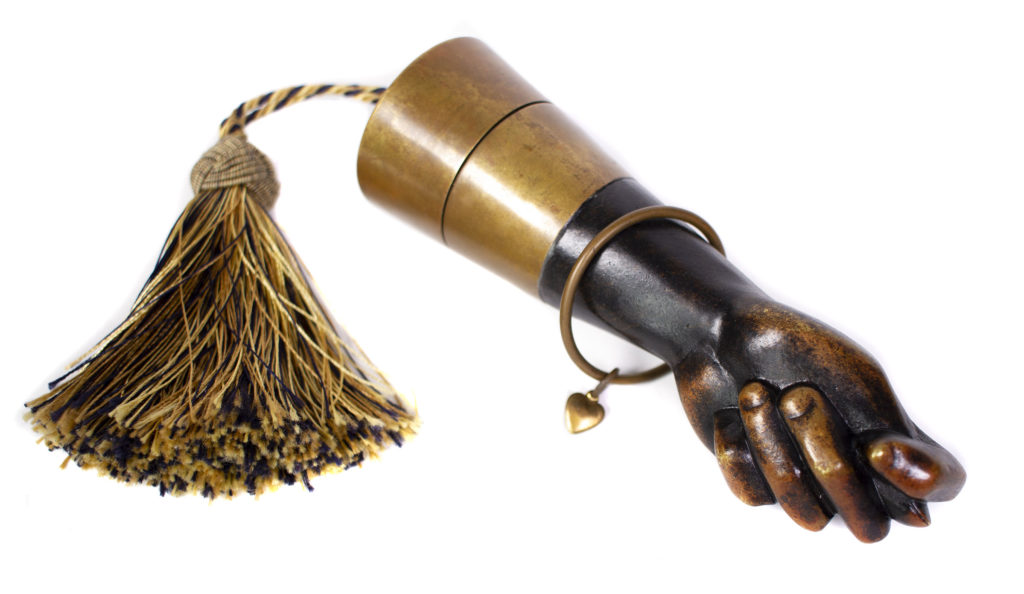
I’ve always admired these figa lighters when I’ve come across them in my searches for Austrian-made brass and bronze. The markings have always intrigued me: “Saks Fifth Avenue” in an elegant, hand-drawn script, and “Made in Austria” in the typical sans-serif of an Austrian mark. They do not come up often, and seem to be somewhat rare, so I was extremely excited when I was able to purchase one. Once I had it in hand, I was convinced it was Auböck. But I soon found there was some controversy surrounding that assessment. These were always attributed to Carl Auböck, but his estate does not have any record of them.
So below I will outline below my best case for the authenticity of these objects.
The lighter features a fist motif with a fig-sign gesture (figa, mano fico, manu fica), that wards off bad luck, and is also a symbol of fertility. The brass part of the hand is heavy and solid, with a rich, black-brown, applied patina, and signs of wear. The case, made of brass, opens up to reveal a cigarette lighter. It stays closed with an embossed dot in the lower part of the lid. There is a modern, V-shaped hinge soldered to the two parts of the brass case and lid. The brass case has been expertly soldered to the hand (as seen by remnants of a silver colored solder) so the welds are barely visible. The lighter can be removed, and the void can be used as a hidden compartment to stash jewelry and trinkets, as the interior is completely hollow. The wrist has a solid brass bangle bracelet from which a heart pendant hangs. Applied to the top of the lid is a brass ball and ring with a gold and navy Turkish knot head tassel. The whole object measures 7 inches (≈18 cm) long and 2 inches (≈5 cm) wide. The tassel is 7 inches (≈18 cm) long. See detailed shots of the lighter below.
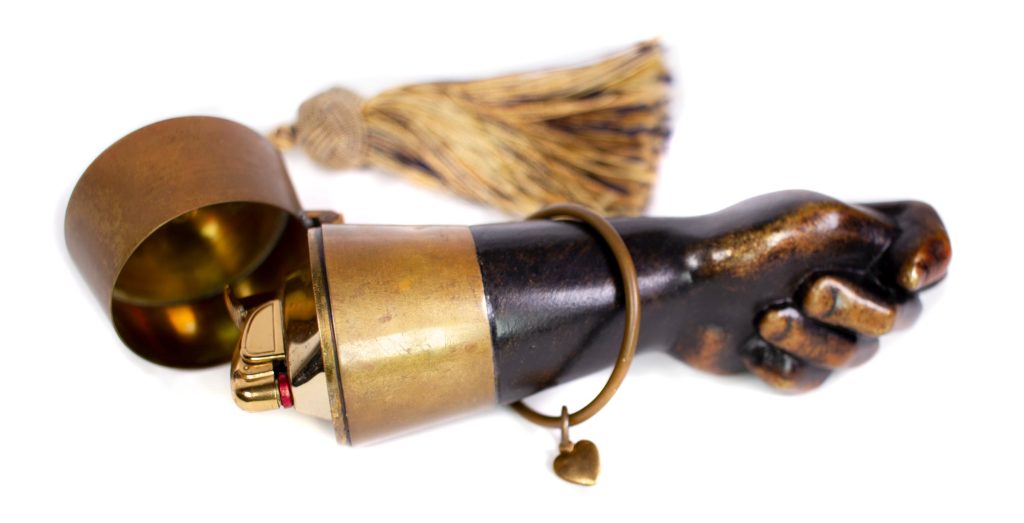



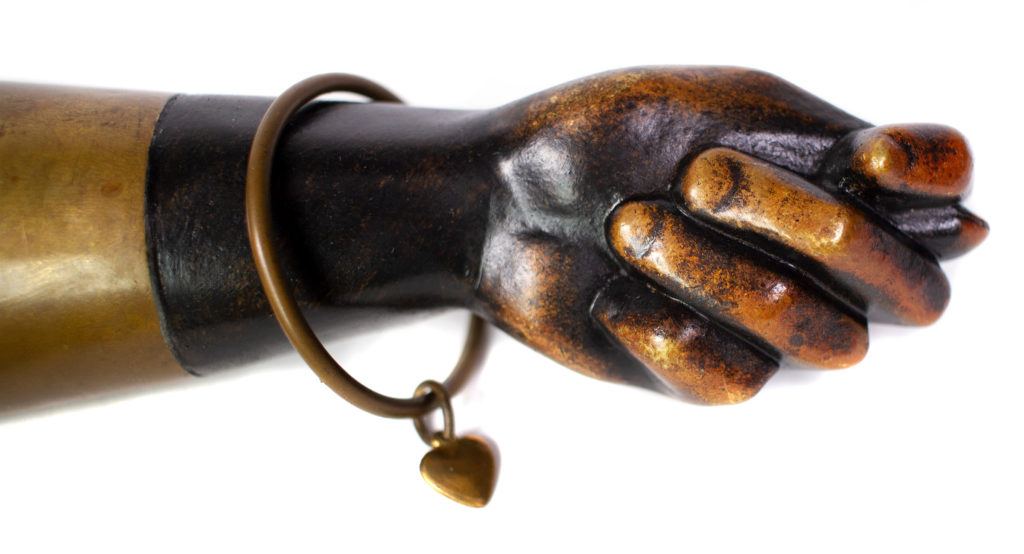


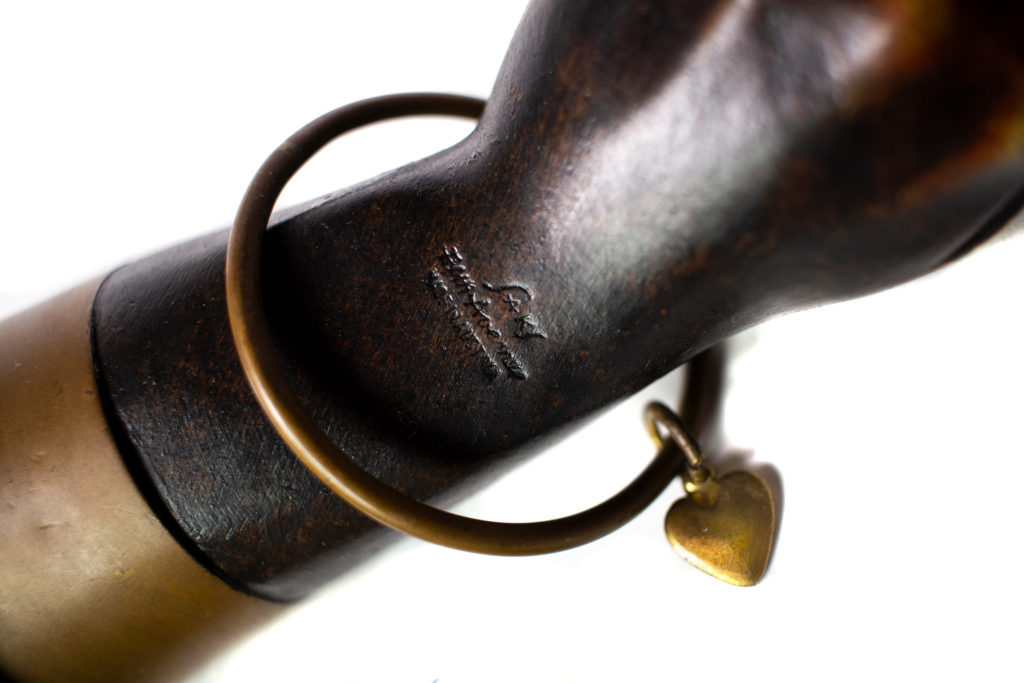
I asked Josh Korwin, font and lettering expert, to weigh in:
I began with the Saks Fifth Avenue logo. In researching the history of the Saks Fifth Avenue retail brand, I found that a huge variety of different hand-lettered wordmarks were used over the decades, some concurrently. A search of the United States Patent and Trademark Office database (TESS, the Trademark Electronic Search System) shows some nearly-identical marks to that which is stamped on the figa, registered in 1955–56. The specific jaunty, modern lettering style seems to have been in use for less than a decade, and only for certain product lines retailed at Saks—by 1961 it was being phased out in favor of other designs. (Branding consistency and identity systems were not nearly as prevalent at the time as they are today.) This alone dates the figa lighter to circa the mid ’50s or very early ’60s. Saks was most often in the business of retailing rather than manufacturing all of their goods in-house, but like many high-end retailers of the time, they would often collaborate with makers of luxury goods to produce items that could be sold exclusively in their stores. It would not be surprising if this relationship meant that the original manufacturer was dissuaded from using their own brand stamp on the wholesale pieces, and only using the country of origin stamp that was required by law for foreign imports.


I then moved on to the MADE IN AUSTRIA mark, set in all caps with a semi-condensed, square-ish sans-serif. Given that many items on the market are marked with these words, it is far more difficult to narrow this down to a specific maker using the phrase alone. Examining it under high magnification, it becomes clear that the mark was likely hand-lettered, but displays some peculiarities that are idiomatic to early-to-mid-20th-century Europe, especially central and eastern Europe:
- The angular style of the “S” almost displays spiked serifs, and there is a reverse stress (horizontally-aligned strokes are thicker than the verticals); thus the central diagonal area of the “S” fades out compared to the strokes above and below.
- Another Art Nouveau / Jugendstil feature of the lettering is the way that the lower portion of the diagonal stroke of the “N” terminates just above the nadir of the rightmost upright stroke, and does not meet in a clean point as would be more typical. With this particular stamp, it appears that the top of the leftmost vertical stroke is missing; it likely also extended above the intersection with the diagonal originally, and could have been broken off with use.
- The “U” has a distinctly asymmetrical shape in which the rightmost vertical stroke terminates at a corner on bottom, but the left side transitions from vertical to horizontal in a gentle curve.
- Other idiosyncrasies include: the mostly rectangular “D”; the “M” whose middle strokes meet in a crotch that rests near the midline rather than falling to the more common baseline, and whose leftmost vertical stroke is partially missing; the damaged leftmost vertical stroke of the “R” (missing its bottom); and the heavy, almost counter-less interior of the last “A” in “AUSTRIA,” which seems to be struck a bit deeper than the preceding letters.
Josh also found that the most similar match to the “Made in Austria” mark used on the figa lighter is also on an ashtray attributed to Carl Auböck from the 1950s and a Carl Auböck brass and leather ashtray, also from the 1950s, both on Patrick Parrish’s website. Using high resolution photography and perspective-correction tools, it was possible to directly align the marks:
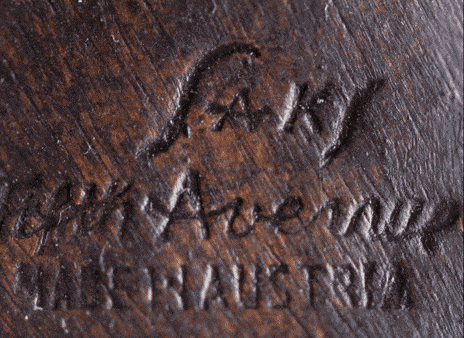


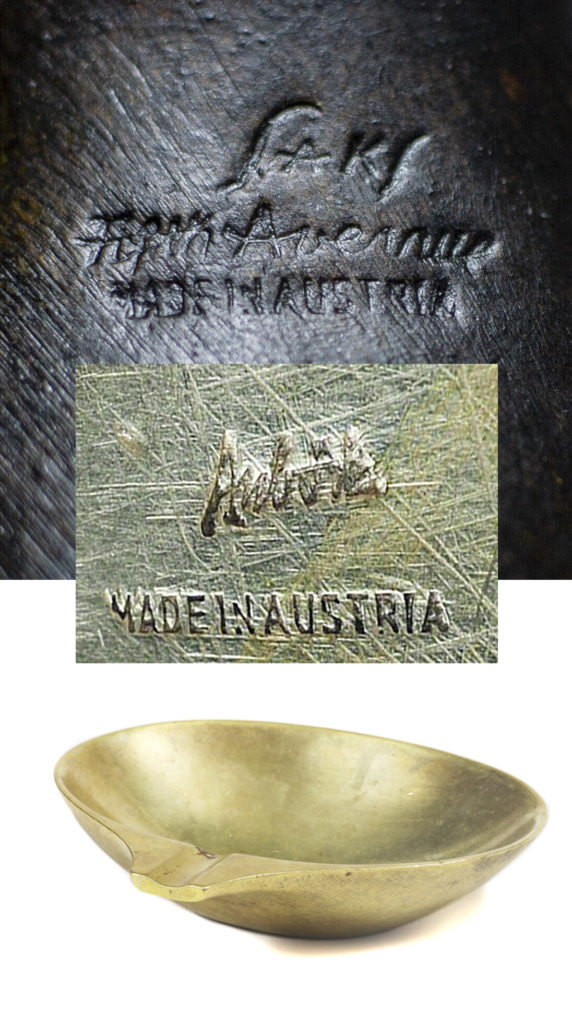
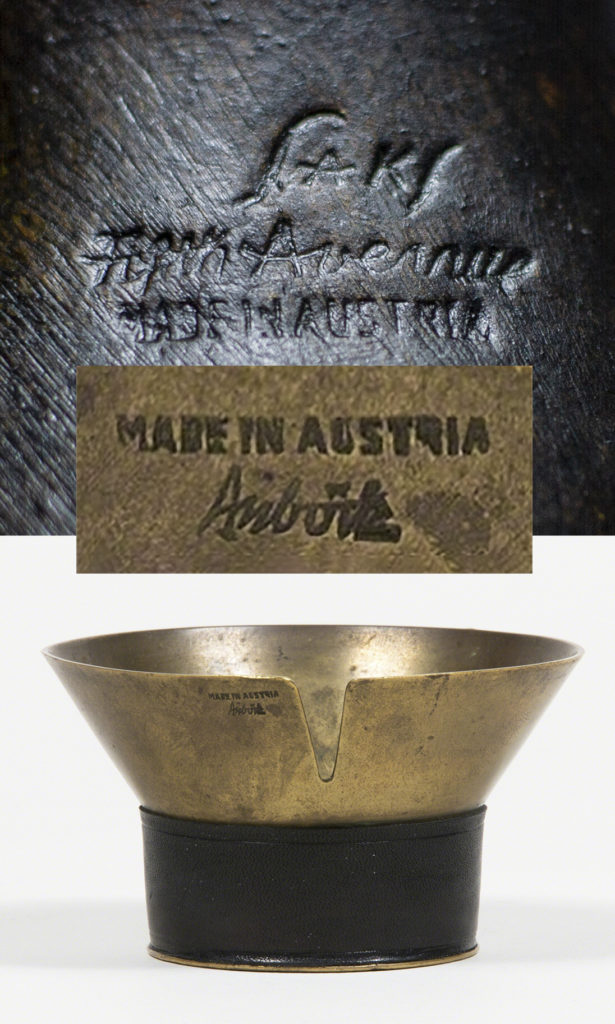
After scouring through the two Auböck books, I found some catalog pages depicting the two ashtrays we used as reference above. These catalog images were from a file of photos dated from between 1948–1957. So the marks you would find on these ashtrays would be from around that time as well. Some other interesting information can be found in the description of this “foto-file,” which states:
“Around 1948 business with the United States department stores started up and was thriving again, so the Werkstätte needed (besides the hand drawn catalogues for inside shop use) good material to communicate with their various overseas customers.”
And later in the next paragraph:
“His father made the first nickel plated brass models after [his] son’s designs for the production of the industrial machine tool.”
So we now know they were working with US department stores and also started using nickel plating at this time (which will become important later). See photo below of the two ashtrays in the foto-file:
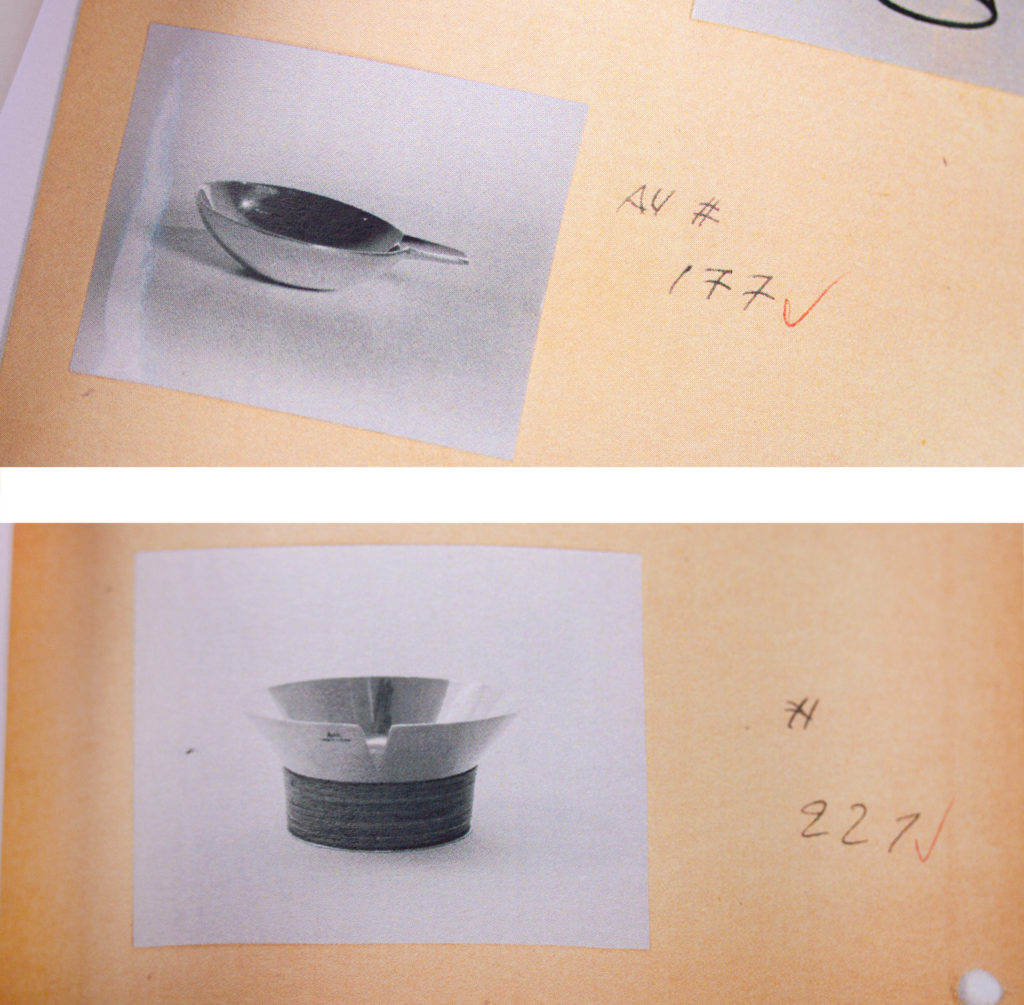
The Object Itself
Regarding the craftsmanship of the figa: this was made with a level of precision casting and knowledge that is extremely fine. I’ve only really ever seen this level of precise casting and finishing from the Hagenauer and Auböck workshops. To get the casting to fit precisely with a standard lighter cartridge is not an easy task. Not to mention the detailed soldering skills and precision casting needed for the hinges. (See images below.)
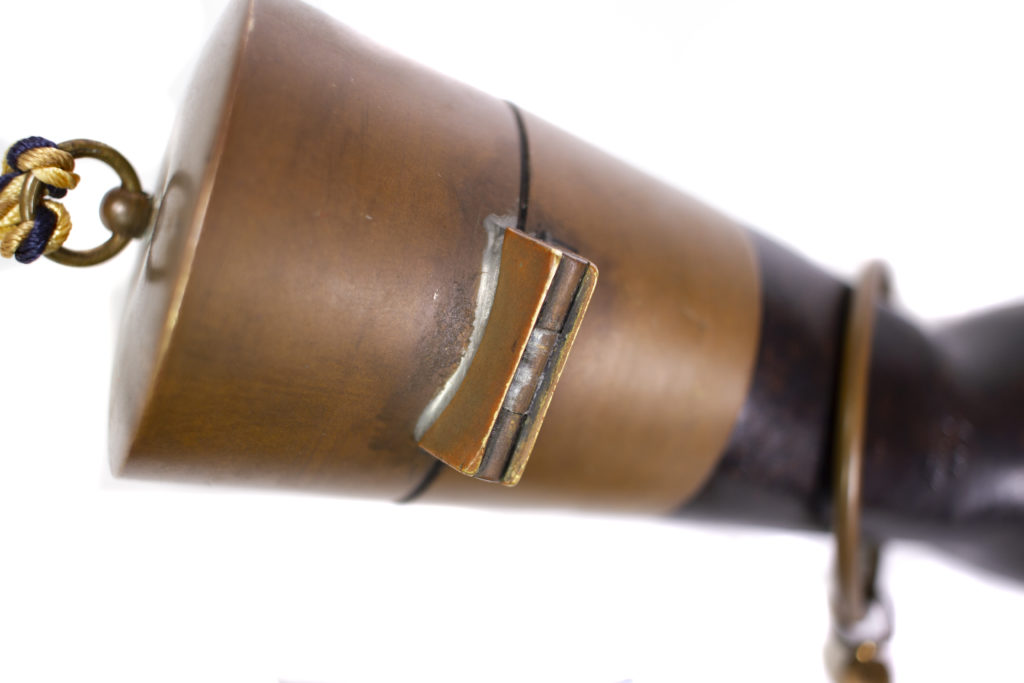
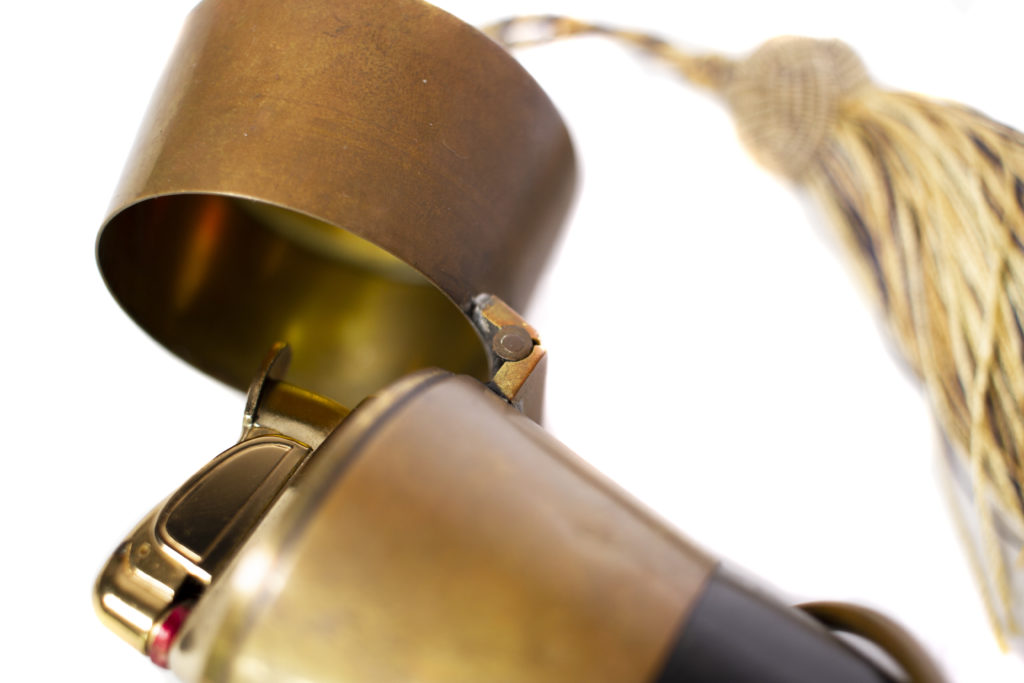
Below is an example of the type of soldering that the Auböck workshop was capable of. I notice a lot of similarities in the type of silver solder used and to the fine finishing techniques on the welds to make a seamless and perfectly flat terminus to the end of the wire bowl.
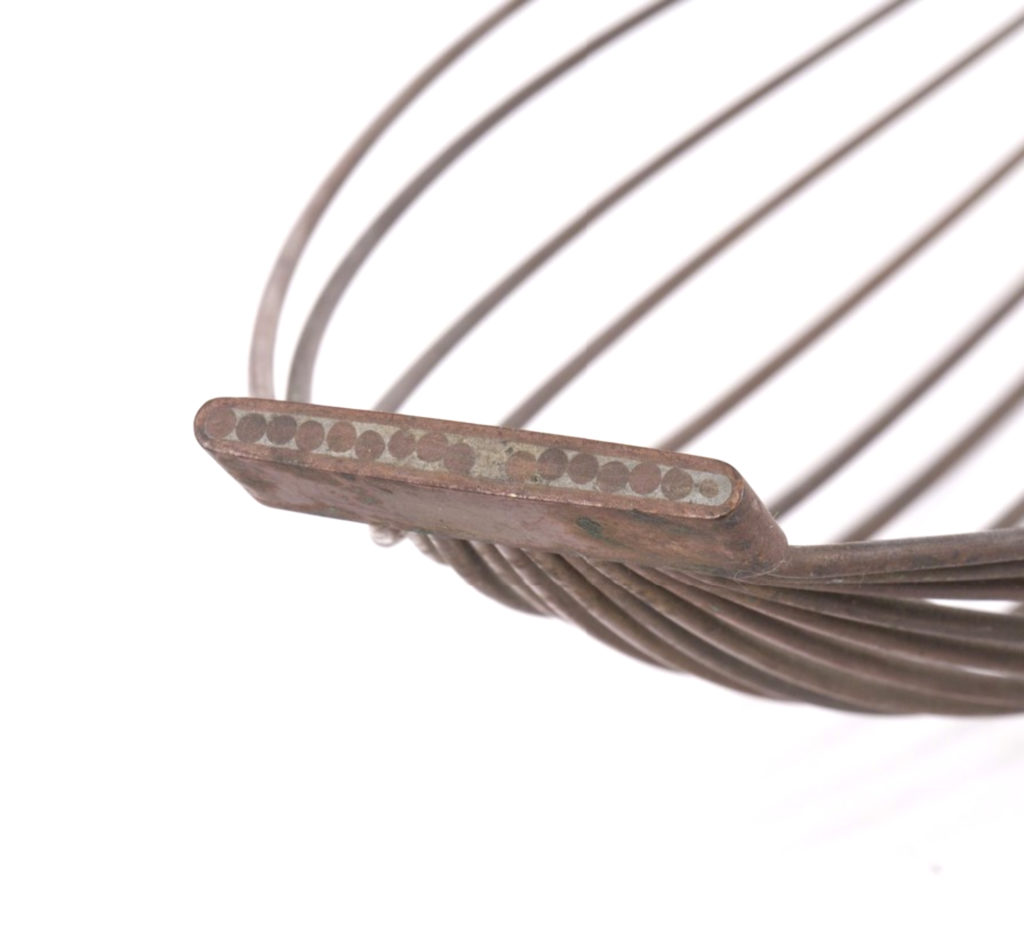
Hagenauer’s Interpretation
I reached out to a representative from Hagenauer who confirmed this item was not made by WHW. And here’s why I believe that is true:
- Hagenauer’s items are designed more in the style of Art Deco or Jugendstil.
- Hagenauer’s “Made in Austria” logos were always presented as a stacked set, with “Made In” always above the “Austria” mark, and text fully justified in its rectangular composition.
These are all the “Made in Austria” logos by Hagenauer:

Hagenauer did produce cigarette lighters, but they were a very different style. Below is an example from Hagenauer Galerie’s website of one of the lighter designs Hagenauer used, as well as an article detailing their various other lighter designs.

The Hagenauer representative also said “I once had a set of ashtrays from Rohac that had the Saks marking. But this does not really look like a Rohac.”
I have to agree here as well. After an extensive search on the internet and in an original Richard Rohac catalog, I was unable to find a single lighter design by him. Rohac was also working in a more realistic, less conceptual style with his animals and people. He was a master sculptor as seen with his bronzes busts. His items that did not depict animals or people, such as letter openers and desk sets, were more geometric in style. Rohac’s “Made in Austria” marks are also very different from the figa lighter’s mark. See Rohac’s marks below:

The Lighter Insert
As far as lighters go, the figa lighter’s insert is consistent with those used in 1950s American table lighters. Since this was made for export to Saks Fifth Avenue in New York, this seems consistent. It could have been sold with an Austrian lighter insert and replaced with an American one after it ran out of fuel, or sold with this one in place. Regardless, the figa has a standard size opening for this type of replacement lighter insert to be used. Carl Auböck was known to use these specific style of lighter insert in his table lighters from the 1950s-’60s. See images of some of his other lighter designs below:
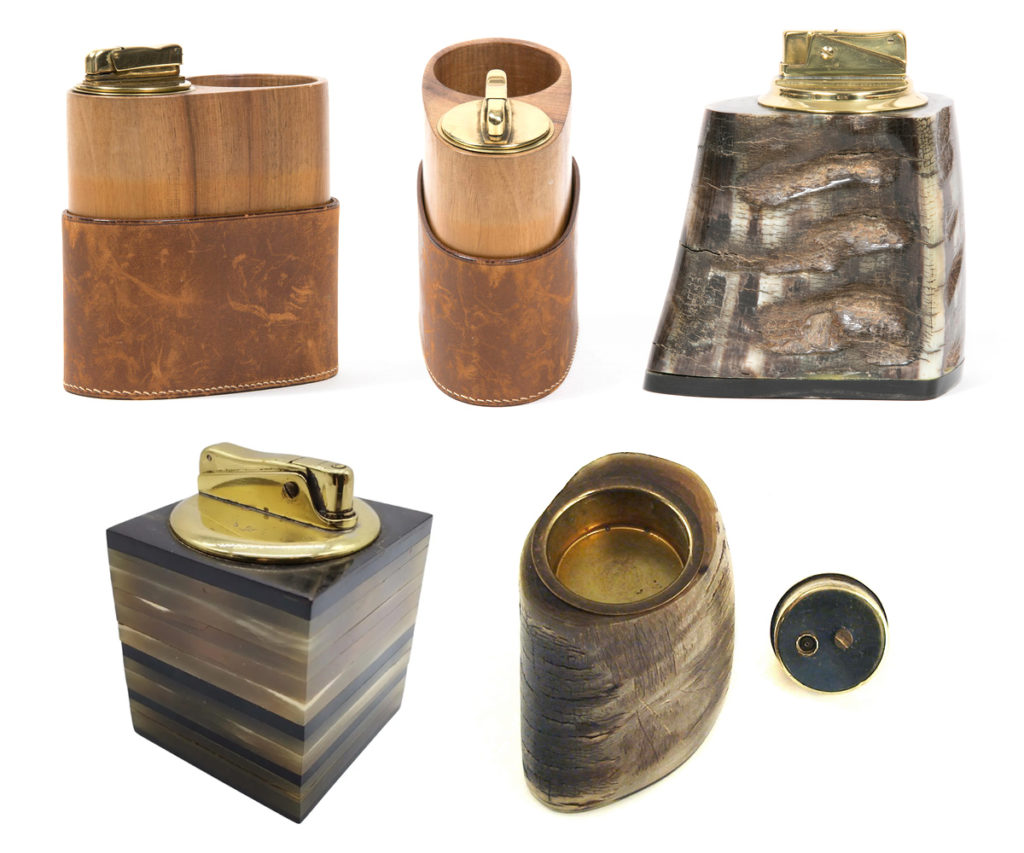


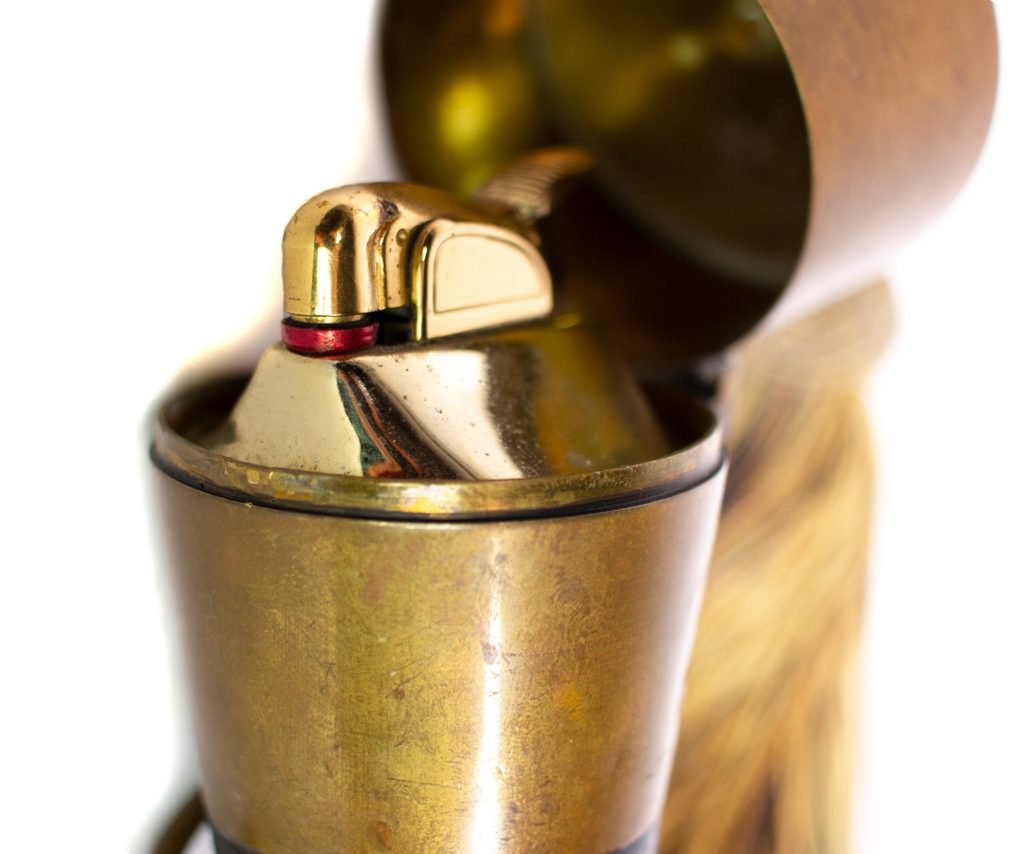
Auböck’s Hands and Feet
Speaking about the motifs used on the figa table lighter, the entirety of its design lends itself well to the Auböck ethos—seeking to elevate everyday objects to things of beauty and value. Here are examples of similar works by Auböck:
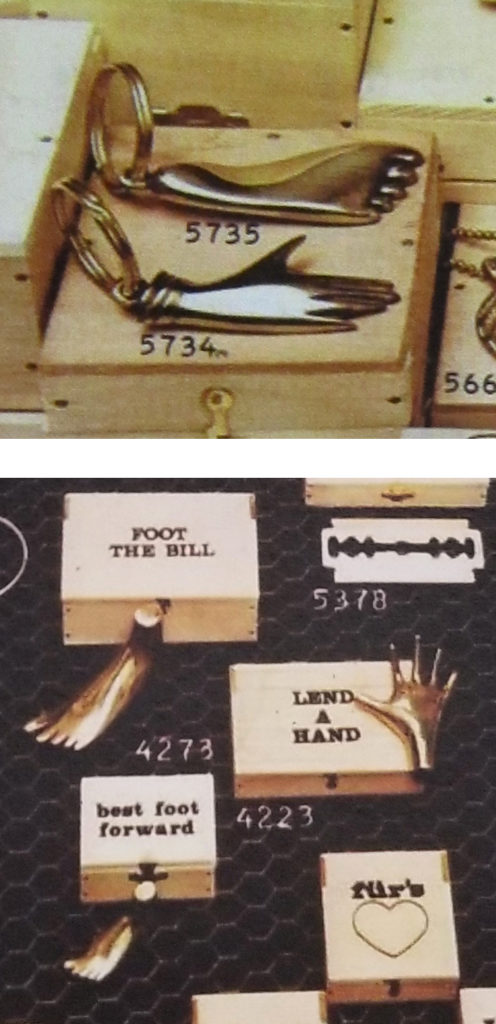

Their workshop often used hands and feet as motifs in their work. One such example under #5275 and 56505 is particularly similar to the figa hand shape. The fingernails were executed in the same style. The figa in reality is much bigger and more detailed than the paperweight, but the artistic styles are very similar. See an original catalog page and a side-by-side comparison of the two hand shapes below.
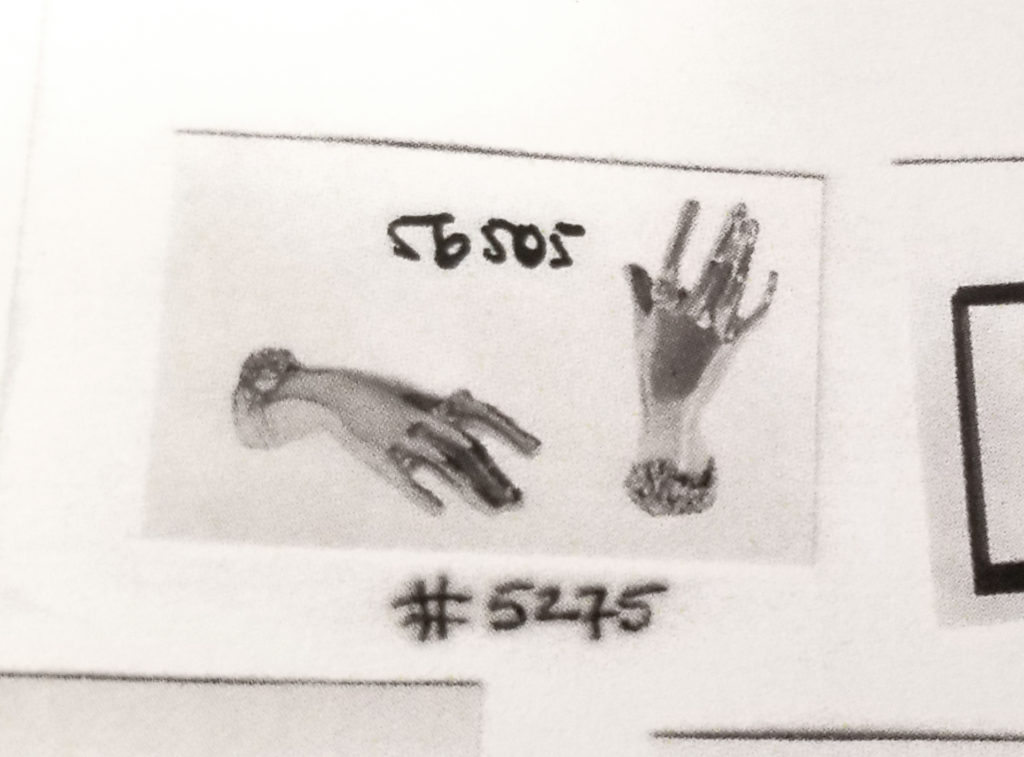
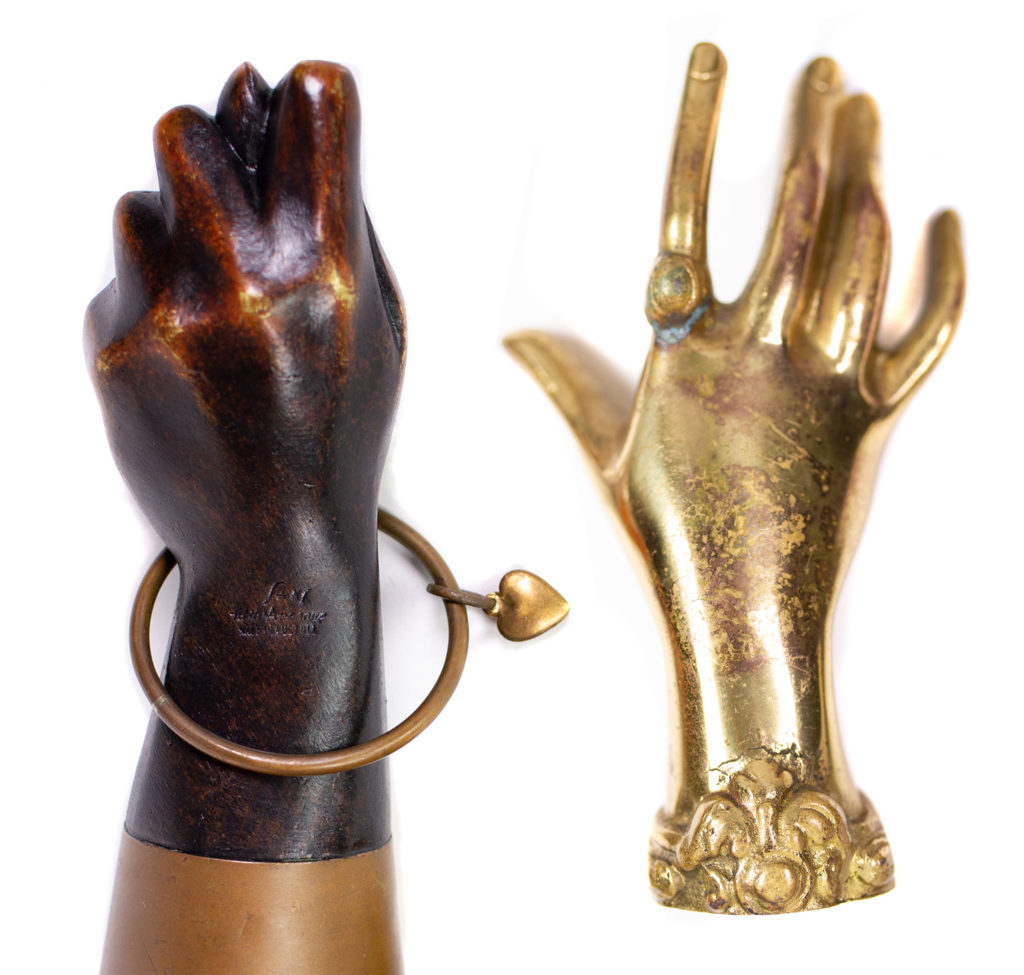

Auböck’s Hearts
Auböck also worked with heart motifs. They had heart shaped paperweights, and particularly of interest to us, heart shaped charms for keychains. Although they are much bigger than the little heart on the bracelet here, they are the similar in design. See below a photo of a catalog page featuring the heart keychain, a modern example of an Auböck heart keychain and the hearts on the figa’s bracelets.
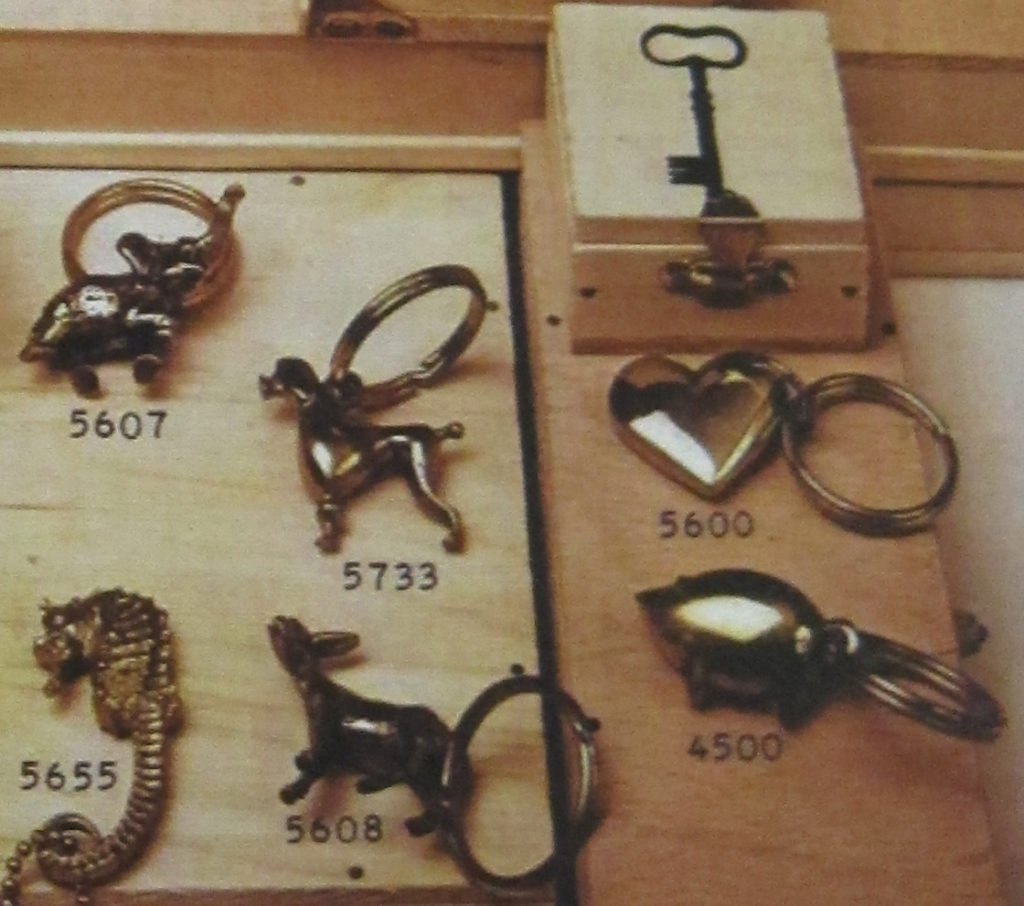


Auböck’s Nickel Plating
The other example of this figa lighter is made with a combination of brass and some kind of silvered metal, probably nickel plating over brass. Hagenauer and Auböck were the only other “Wiener Bronze” makers known to mix their brass/bronze work with other materials like nickel, steel and wood. Rohac worked primarily in brass/bronze and with some wood, but never any nickel plating. Here is a photo of the nickel plated figa:
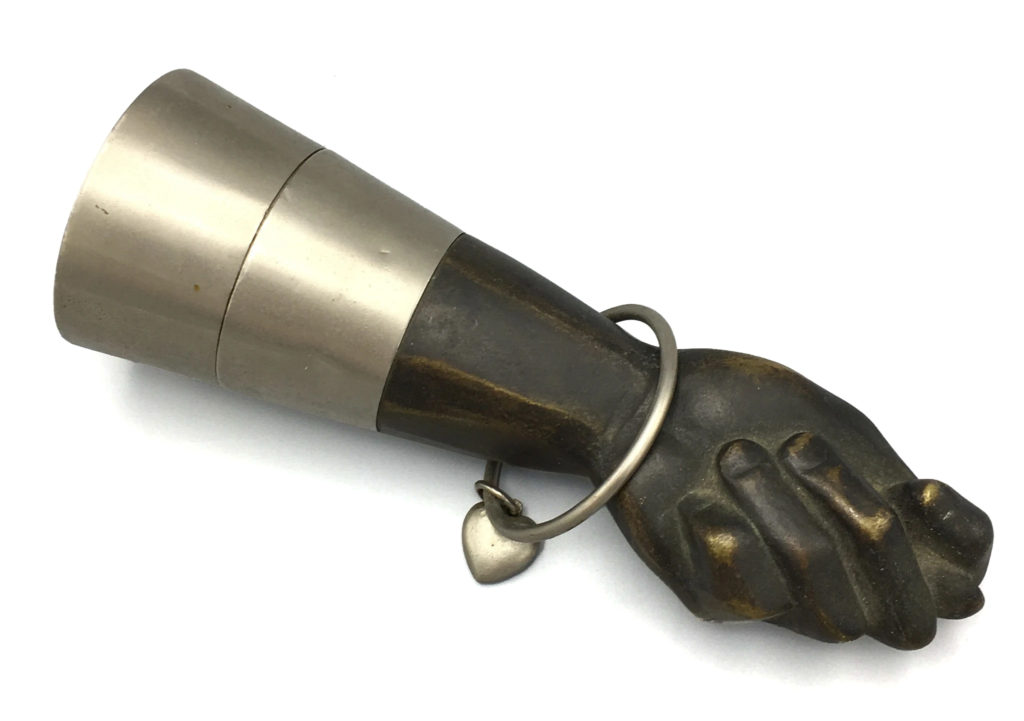
And here are some examples of the nickel plating that was done in Auböck’s workshop. See how the same items were plated and finished in different ways:


The Horse’s Hoof
Please Note: It takes a great deal of time, effort, and money to maintain the museum collection, host this website, create informative posts, and respond to authentication and identification requests. Thank Alyssa for her expertise and authentication assistance here—tips are greatly appreciated!
Buy a Coffee for Alyssa!In doing all this research I also came across another item with the same “Made in Austria” and “Saks Fifth Avenue” marks. It is a horse’s hoof, cast in bronze, with an applied black patina and a silver nickel-plated horseshoe, attached with tiny brad nails. The horseshoe is the most detailed and interesting part of the whole object, but then why would they put the makers mark right in the middle of it? As an object, something was missing! The back side has two open screw holes and one large hole in the middle. It is also marked with the number “24” (workshop code?) in the lower left corner. See photos below:

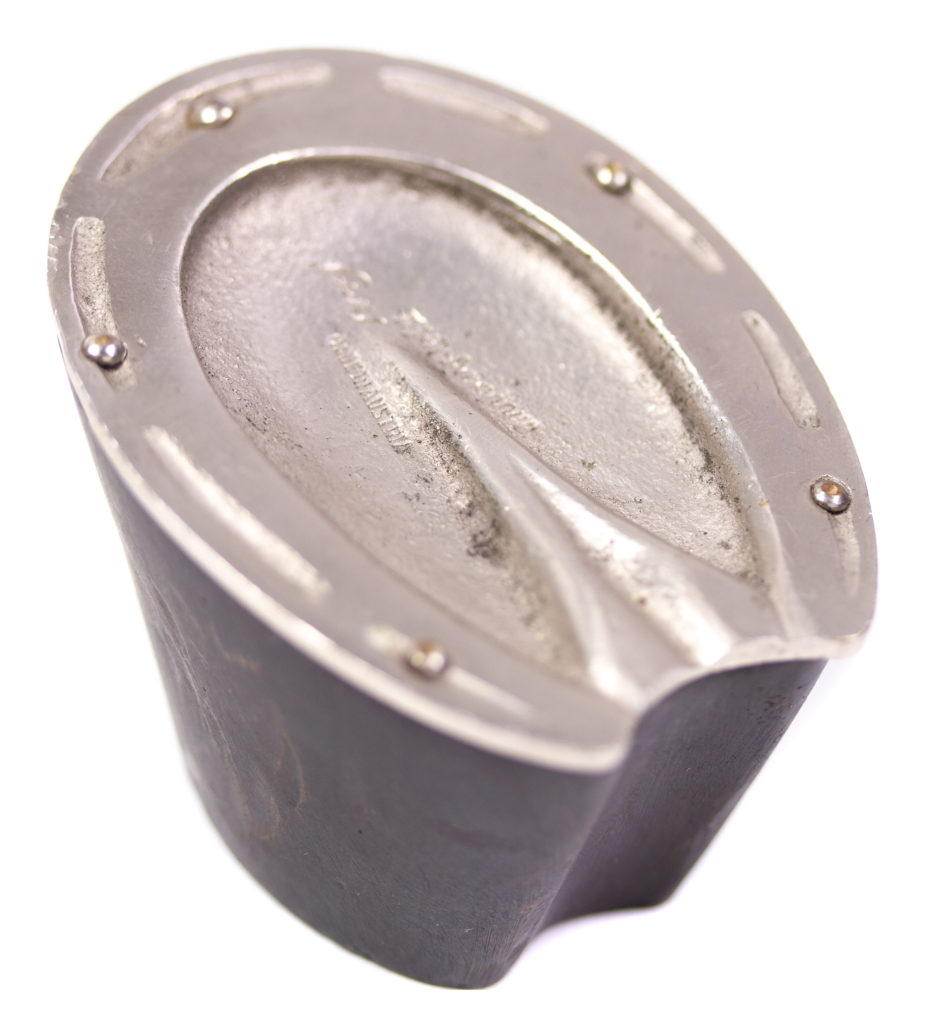
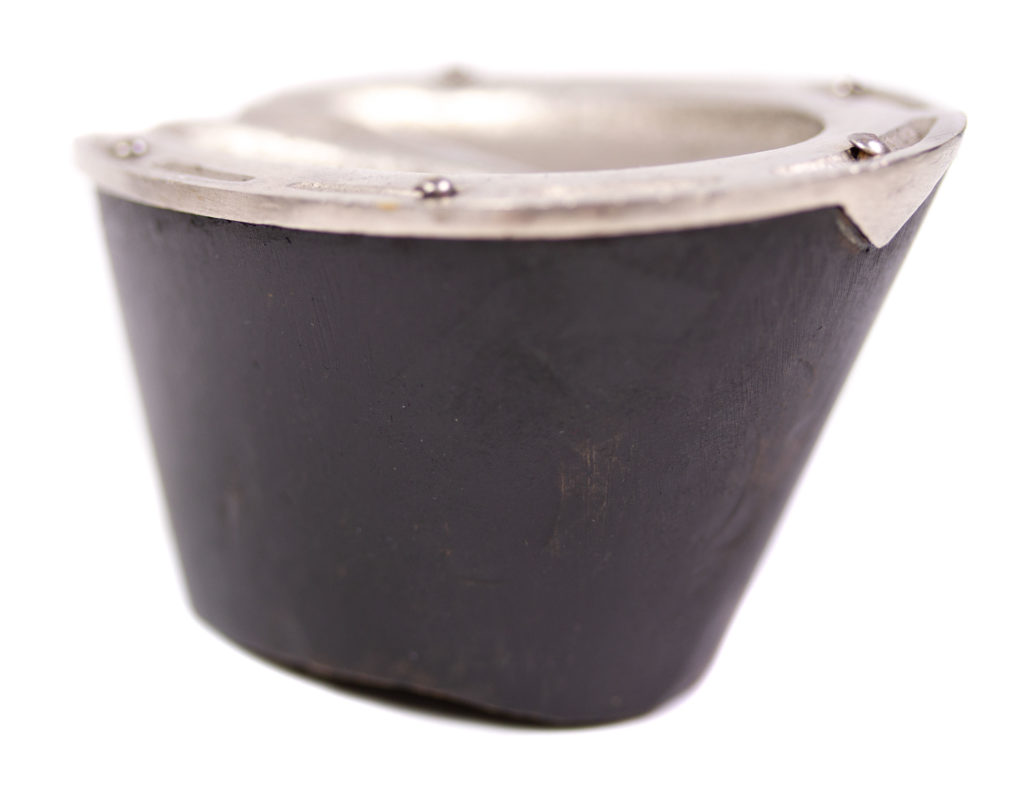


So after a bit more research I found what this was originally supposed to look like! The beautiful horseshoe was supposed to face down (what I think is the best part of the whole object) and functions as the base. The top looks like it was used for holding matches, or perhaps toothpicks. Or it could also be the right size for another lighter cartridge. I cannot be sure because I do not have access to the dimensions of the compartment. Here is a photo of a fully intact example, depicting what it is supposed to look like:
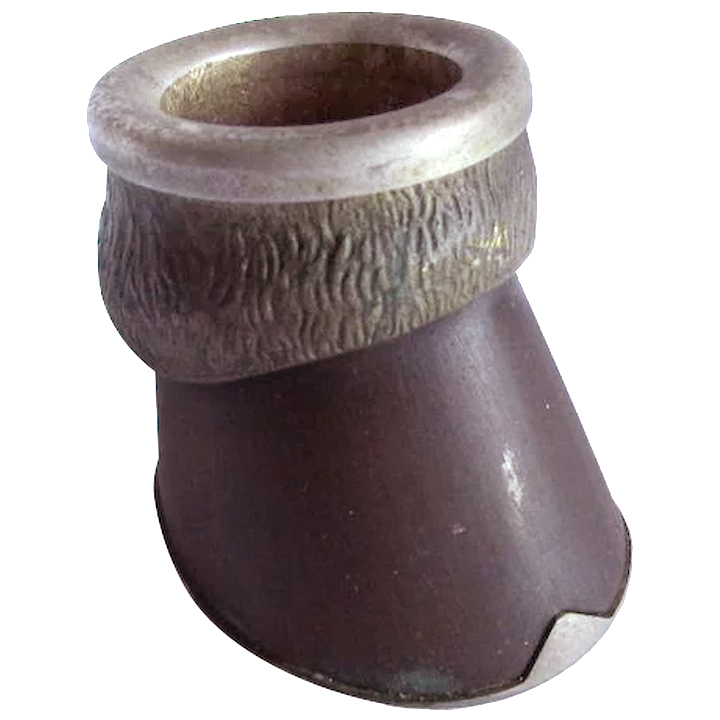
Auböck’s Horseshoes
Auböck also worked with horseshoes as a motif. There is a horseshoe shaped pencil holder in the catalog (which could also be ordered nickel-plated in silver) and a horseshoe shaped paperweight that came in a box “a gift from a very special horse.” See below:
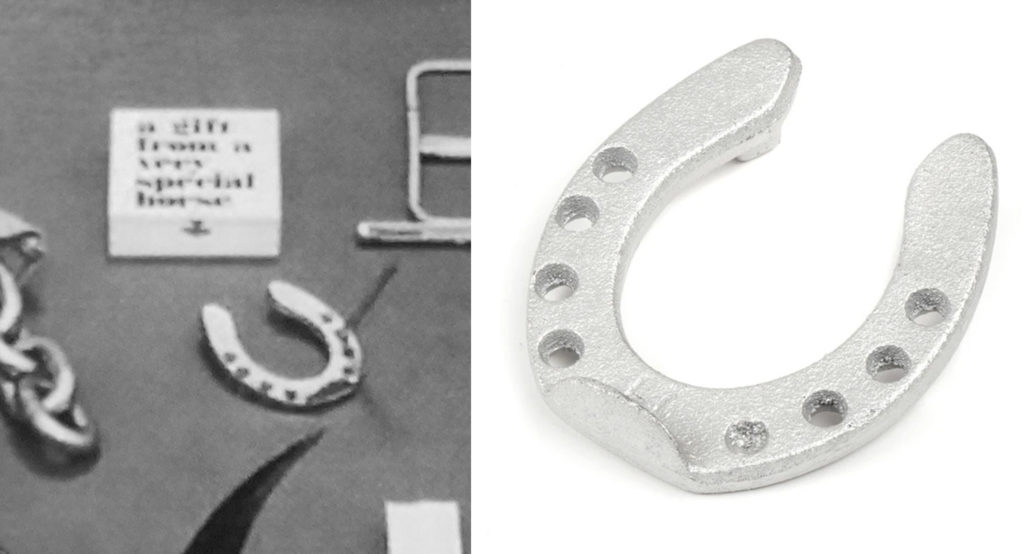


The Hoof’s Markings
The mark on my horseshoe is the same “Made in Austria” mark present on the figa lighter and Auböck ashtray, though it does not show the exact same nicks/damage present on the striking die. (The Saks Fifth Avenue marks are of the same design.) The lack of the exact same nicks in the “Made in Austria” die does not disprove the whole case; the horseshoe could have been struck earlier, before the die had received more damage, or could have been struck harder or had been softer and thus accepted the mark better. My guess is they struck it harder because they knew the nickel plating would fill in some of the details. Here is a photo of the horse hoof mark up close:
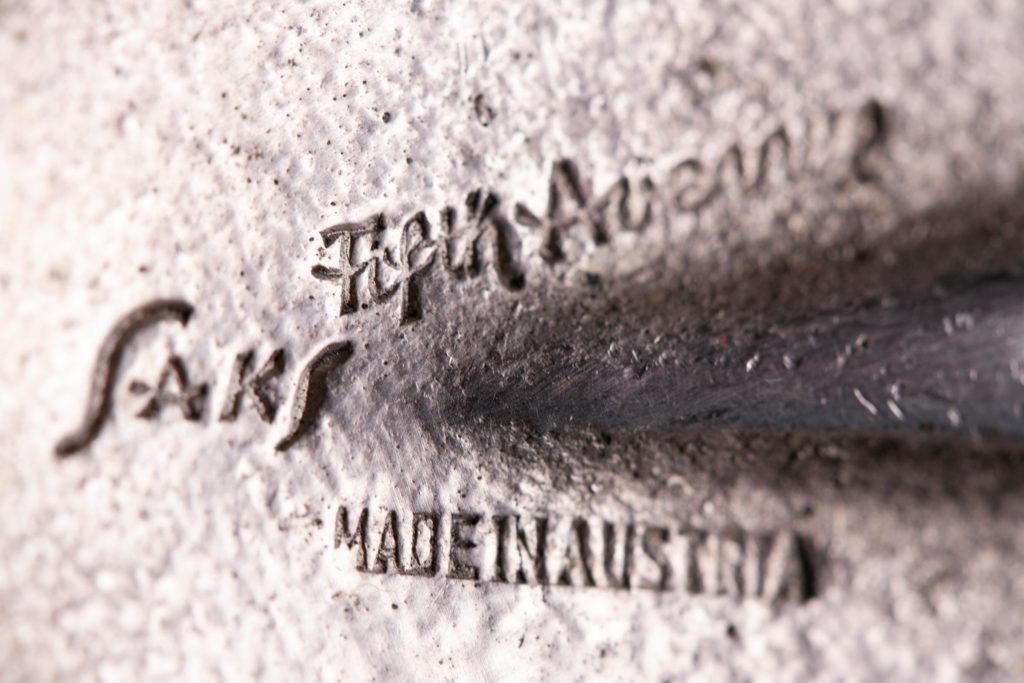
Richard Rohac and Saks Fifth Avenue
Now we come to our last curious example of an Austrian-made Saks Fifth Avenue collaboration: the aforementioned ashtray designed by Richard Rohac that the Hagenauer representative mentioned. The “Made in Austria” mark on the tamper is Rohac’s characteristic mark, with the letterforms arched, centered, and stacked atop each other. The second mark on the ashtray is also his “Handmade in Austria” mark. The “Saks Fifth Avenue” mark is similar, but with a tiny “for” added in front of the “Saks Fifth Avenue” mark. Here is a photo of it:
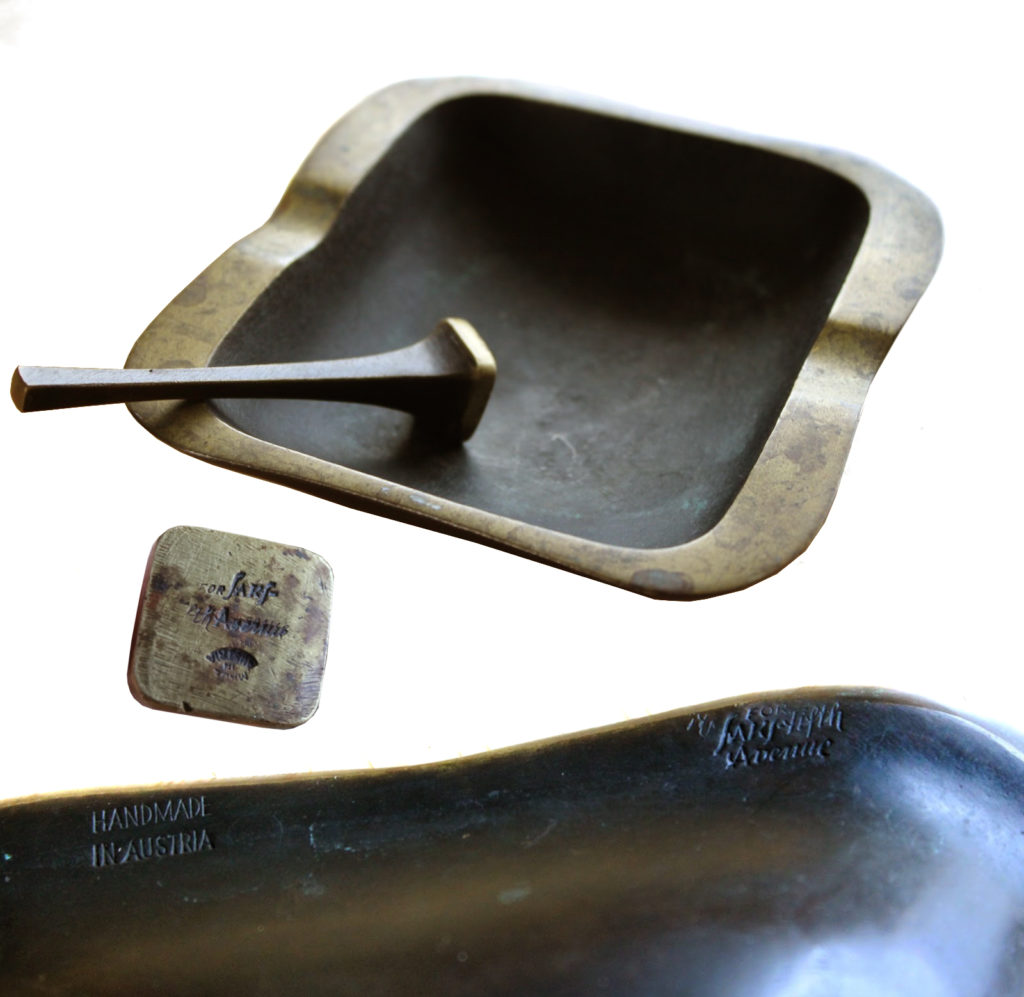
The design is particularly within Rohac’s wheelhouse: a geometric shaped ashtray and tamper with applied black patina and polished brass highlights. In fact, it shows up on page 45 of his catalog under model #7. So there is no confusion about who manufactured it. Here is a photo of that page:
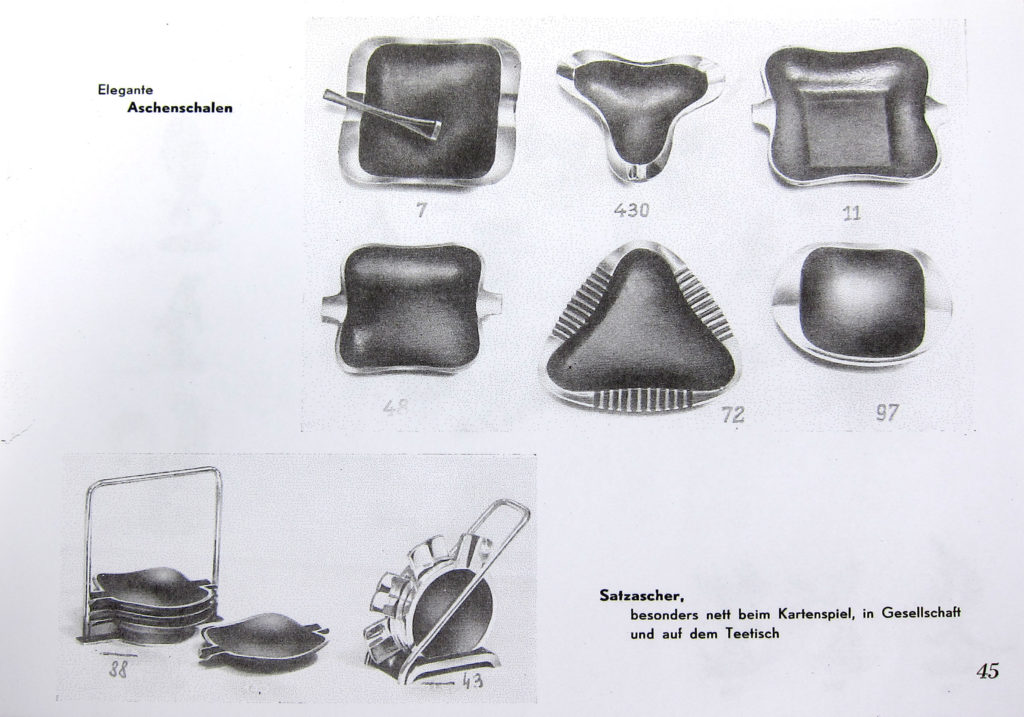
Josh again:
Upon close examination, it becomes clear that when comparing the figa lighter marks to those of the Rohac ashtray, there are distinct differences. The MADE IN AUSTRIA (figa) and HANDMADE IN AUSTRIA (Rohac ashtray) are clearly different in phrase and letterform, with the Rohac piece displaying a modernist, geometric sans-serif lettering design, similar to fonts like Erbar or Futura. But the Saks Fifth Avenue marks differ as well. The initial “S” is longer and straighter on the Rohac. There is a hyphen present on the Rohac mark after the word “Saks.” The “K” on the Rohac piece has a wider, more sweeping look, with the lower diagonal meeting the upper diagonal away from the upright vertical stroke. The figa’s “K” has all of its strokes intersecting at one point. Plus the inclusion of FOR, and the deliberately-different groupings of the words (certainly made with separate stamps for maximum versatility) speak to the work and creative choices of a different craftsperson.

It seems logical to assume that the Saks Fifth Avenue logo or stamps would have been provided to the studio creating the commissioned pieces, rather than the pieces being marked upon arrival to New York City. For one thing, the marking process requires skill and practice to leave a clean, legible impression without damaging the piece—and although it is possible that Saks could have employed someone to do this, it seems far more reasonable to let the original artisan mark the piece with several stamps all at once. The more important clue, however, is that the pieces were clearly marked before patination or plating, otherwise the steel die would have cut through the outer layer and revealed shiny, gold brass underneath. This could only have been done by the original studios. Thus Saks most likely collaborated with Rohac and the maker of the figa lighter separately, providing them each with their own set of handmade marking dies or the graphics to make their own. It seems far less likely that the Rohac studio created both pieces contemporaneously, but used different marks on each.
TL;DR: After all of this, I know the figa lighter and hoof are not designed by Rohac. His workshop really did not seem to have the high level of skill needed to mix metals and achieve this precision casting. Rohac did not make lighters and did not work with nickel plating. Though we know of a Rohac/Saks collaboration, that ashtray has maker’s marks that look nothing like the figa lighter nor the horse hoof, and is a typical Rohac-designed product sporting his markings.
They are not Hagenauer pieces, because their workshop’s markings are not used. Hagenauer did work with nickel and had the skills to produce this piece, but Hagenauer’s lighters are differently designed, and their artistic style is typically more art nouveau / Jugendstil.
There is always the possibility the figa could have been created by some unknown maker, but I do not know of any other Austrian workshop that could manufacture something to this level of quality. And if there was such a workshop out there, why have we not seen any other similar products on the antiques market?
The figa lighter and the Auböck ashtray together make the strongest case.
My conclusion: the figa lighters are made by Auböck. They worked with the same realistic, representational artistic style and sought to elevate everyday objects to things of beauty and value. Even if there is no direct record of this piece, there are gaps in the catalogs, even for known and marked items.
The Auböck-designed hand-shaped paperweight is very similar in style to the figa, and the little heart keychain also looks almost identical in design to the charm bracelet. The lighter inserts used were the same size and shape Auböck was already known to have used. For the horse’s hoof design, Auböck also has many similar horseshoe-shaped models in his catalogs. The dates of the identically marked Auböck ashtrays and the date of the figa lighter all match up with this specific “Saks Fifth Avenue” logo’s use.
To me, all these elements together make a pretty compelling case for this figa lighter and horse’s hoof object to be authentic Auböck designs. And that is not to mention the fact that the striking die used on both an authentic Auböck-signed ashtray and the figa lighter have idiosyncratic damage in the exact same places. If I were on the jury for a court case about this design and I had to cast my vote, I would have to conclude this is an authentic Auböck design.
What do you think?
Happy collecting, and I hope you found this informative.
Update (11/29/2021)
We solved a mystery! Huge thanks to the Auböck estate for providing all this detailed information! After searching in their vaults they were able to find the original “Saks Fifth Avenue” marks and some very similar “Made in Austria” punches. The “Saks” and “Fifth Avenue” are separate punches as we suspected. It looks like they also had a version of their “Made in Austria” punch where the text is split and stacked. I can see this mark coming in handy when trying to identify something in the future.
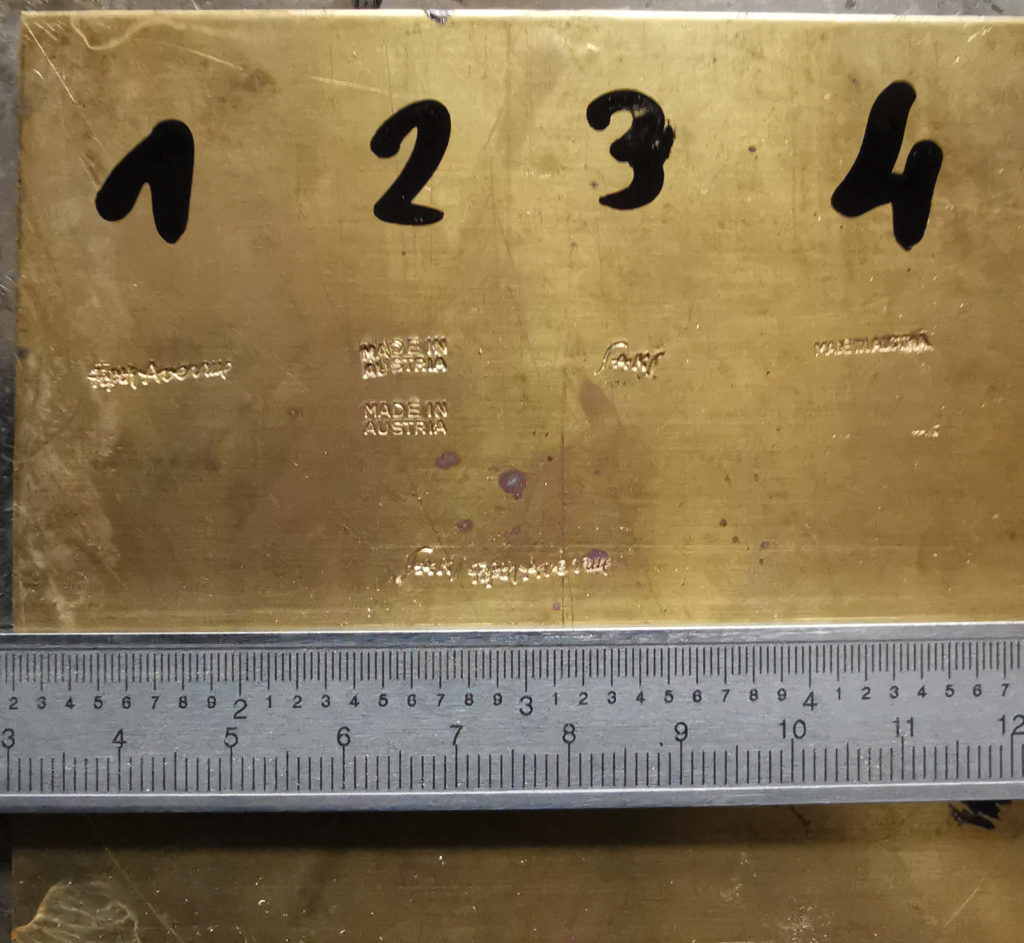
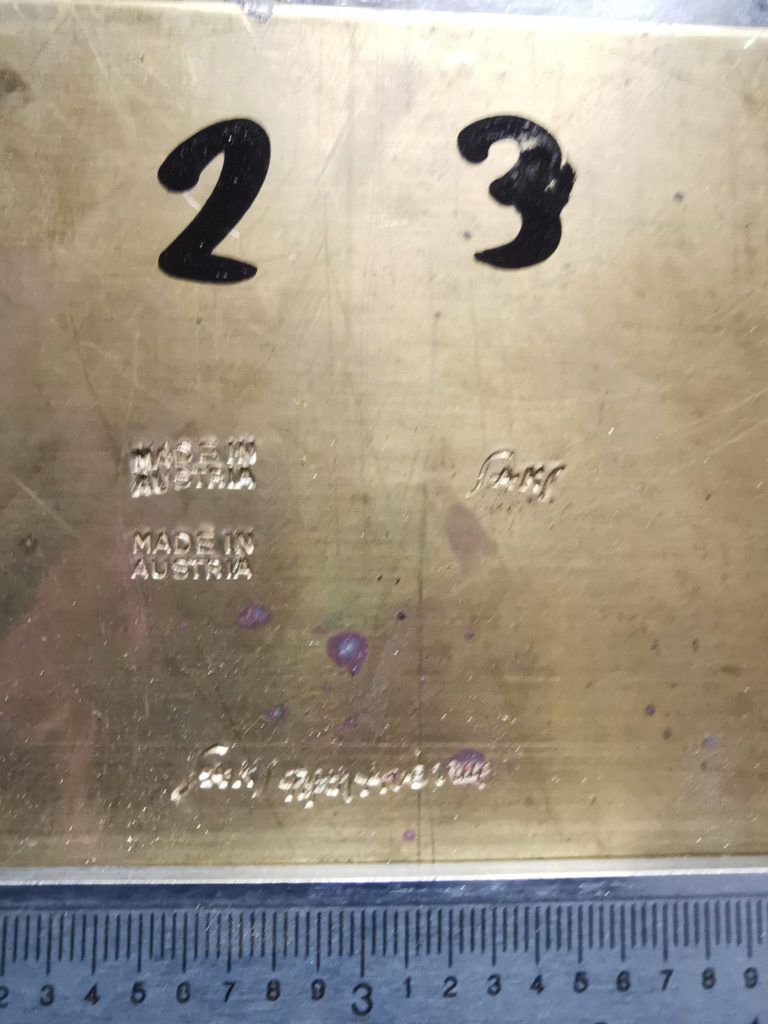
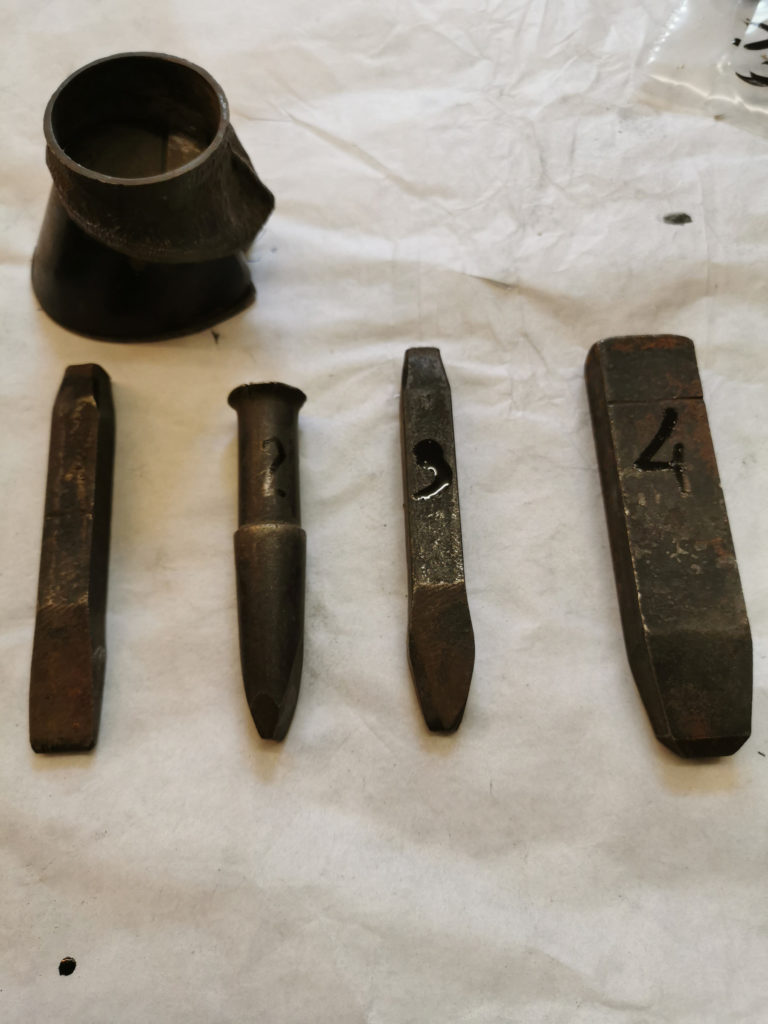
In another exciting update, they also found the master for the mysterious horse’s hoof/horseshoe. Turns out it was in their archives and they were never able to place it in the collection. Very interesting is the mark of “24” on the bottom of the horseshoe (corresponding to the “24” on the back of our above hoof).



Probably most interesting of all is the mysterious “Christian Dior” mark right next to it! What does that mean? After a small bit of research, we did find Christian Dior making table lighters with very similar lighter inserts. Could this be its original use?

Thanks again to the Auböck Estate for helping solve this mystery!
Congrats on making it all the way to the bottom of this article! It’s a long one. Thanks from the team here at Modern Vienna Bronze. If you want us to furiously research something for you, drop us a line!
